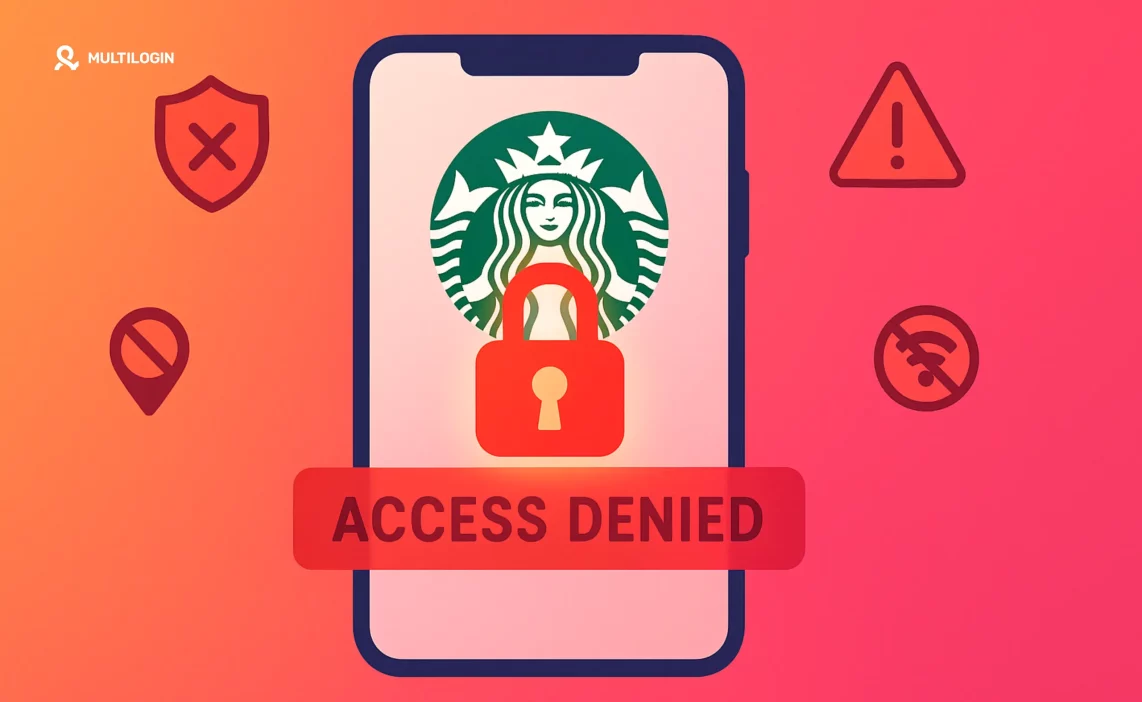You’re standing in line at Starbucks, ready to order your favorite caramel macchiato, and suddenly—your app won’t load. The rewards you’ve been saving? Inaccessible. Your payment methods? Gone. You check Reddit, and sure enough, others are experiencing the same nightmare: Starbucks has blocked your IP address.
This isn’t just an inconvenience. For frequent travelers, digital nomads, or anyone managing multiple Starbucks accounts for business purposes, an IP ban can feel like being locked out of your digital coffee sanctuary. The good news? You’re not alone, and there are proven solutions that go far beyond basic VPNs.
If you’re tired of worrying about account bans and access restrictions, Multilogin offers a professional solution that lets you manage multiple accounts safely with advanced antidetect technology. Starting at just €5.85/month, you can say goodbye to IP bans permanently.
What Is a Starbucks Mobile App IP Ban?
A Starbucks mobile app IP ban occurs when Starbucks’ security systems flag your IP address as suspicious and block access to their services. Think of it as a digital bouncer refusing entry to the club—except instead of checking your ID, Starbucks is analyzing your connection patterns, device fingerprints, and account activity.
When you’re banned, you’ll typically see error messages like:
- “Unable to connect to Starbucks servers”
- “Service temporarily unavailable”
- “Please try again later”
These vague messages rarely explain the real problem: your IP address has been blacklisted.
Does Starbucks Block VPN?
Yes, Starbucks actively blocks VPN connections, especially on their mobile app. While you might think a VPN would solve your access problems, Starbucks employs sophisticated detection systems that identify VPN traffic patterns. When they detect a VPN, they often block the connection entirely or flag your account for suspicious activity.
Moreover, VPNs aren’t designed for multi-account management. They only mask your IP address, leaving dozens of other identifying markers completely exposed. This includes:
- Browser fingerprints
- Device characteristics
- Canvas fingerprinting data
- WebRTC leaks
- Timezone inconsistencies
- Screen resolution patterns
Starbucks’ anti-fraud systems analyze all these factors, which explains why even premium VPNs often fail to prevent bans.
Why Is My Starbucks Mobile App Not Working?
Several factors can trigger Starbucks app malfunctions, though IP bans represent just one piece of the puzzle:
1. IP Address Blacklisting
Using public WiFi, shared networks, or previously flagged IP addresses can trigger immediate blocks. Starbucks maintains extensive IP blacklisting databases that track suspicious connection sources.
2. Multiple Account Access
Attempting to manage multiple Starbucks accounts from the same device or network sends red flags to their fraud detection systems. Businesses running loyalty programs or gift card operations particularly struggle with this limitation.
3. Geographic Inconsistencies
Logging in from different countries within short timeframes triggers security alerts. This particularly affects frequent travelers and remote workers.
4. Device Fingerprint Mismatches
Starbucks tracks your device fingerprint—a unique identifier based on your phone’s hardware and software configuration. Suddenly accessing your account from a completely different device type raises suspicions.
5. Automated Activity Detection
Using bots, scripts, or automation tools to claim rewards or make bulk purchases will almost certainly result in a ban. Starbucks employs advanced bot detection software that identifies non-human behavior patterns.
Is Starbucks IP?
Starbucks isn’t an IP address itself, but the company absolutely tracks and manages IP addresses as part of their security infrastructure. Every time you connect to the Starbucks app, their servers log your IP address alongside dozens of other data points.
Starbucks uses this information to:
- Prevent fraud and unauthorized access
- Enforce regional restrictions
- Block suspicious account activity
- Maintain payment security
- Track customer behavior patterns
Understanding what is an IP address and how companies use it for tracking is crucial for anyone managing multiple online accounts.
How Do You Change Your Country on the Starbucks App?
Officially, you cannot simply change your country setting on the Starbucks app. Each Starbucks region operates independently with separate accounts, rewards programs, and payment systems. A US Starbucks account won’t work in the UK, and vice versa.
However, if you’re traveling or relocating, you face several challenges:
The Geographic Lock Problem
Starbucks uses geolocation data to determine your actual location. Even if you manage to access the app through a VPN, the payment methods and rewards won’t transfer between regions.
The Workaround
The only legitimate method involves creating separate accounts for each country. This creates a new challenge: managing multiple accounts without triggering fraud detection systems.
This is where antidetect browsers become essential. Unlike VPNs that only mask your IP, antidetect browsers create completely unique browser fingerprints for each account, making it appear as though you’re accessing each account from entirely different devices.
Can I Use the US Starbucks App in the UK?
Technically, no—the US Starbucks app is region-locked and designed to work only within the United States. Attempting to use it in the UK will result in connection errors, payment failures, and potentially account restrictions.
Furthermore, trying to bypass these restrictions with basic VPNs often backfires. Starbucks can detect VPN usage through:
- Known VPN IP ranges
- Connection inconsistencies
- WebRTC leaks that reveal your true location
- Timezone mismatches
Instead of fighting against regional restrictions, savvy users create separate accounts for each region and manage them properly using multi-account management solutions.
Can I Use Starbucks Internationally?
While Starbucks operates in over 80 countries, their mobile app ecosystem remains fragmented by region. You cannot transfer rewards, payment methods, or account data between countries. Each market requires a separate account with localized features.
This creates headaches for:
- International travelers who want to maintain rewards across regions
- Digital nomads working from different countries
- Businesses managing gift card programs globally
- Loyalty program enthusiasts trying to maximize rewards
The solution isn’t to fight the system—it’s to work within it intelligently using proper tools.
Starbucks Mobile App IP Ban Reddit: What Users Are Saying
The Starbucks subreddit and various tech forums overflow with frustrated users sharing IP ban experiences. Common threads include:
“Changed countries for work, now locked out completely”
Users report that moving to a new country often results in both their old and new accounts getting flagged for suspicious activity.
“Public WiFi got my account banned”
Coffee shop WiFi (ironically) and hotel networks frequently share IP addresses with thousands of users, many of whom may have already been flagged by Starbucks.
“VPN didn’t help, made it worse”
Multiple users report that using VPNs to bypass restrictions actually triggered permanent bans rather than solving their problems.
“Multiple accounts for family all suspended”
Parents managing separate accounts for family members on the same network frequently face mass suspensions when Starbucks flags the shared IP address.
Starbucks Mobile App IP Ban List: How It Works
While Starbucks doesn’t publish their IP ban list publicly, their system operates similarly to other major platforms with sophisticated anti-fraud measures:
Dynamic Blacklisting
Starbucks maintains a constantly updated database of flagged IP addresses. These lists include:
- Known VPN server ranges
- Proxy server IP addresses
- Data center IP blocks
- Previously banned user IPs
- Public network ranges with high fraud rates
Risk Scoring
Rather than implementing hard bans immediately, Starbucks uses IP risk scoring to evaluate connections. High-risk factors include:
- Multiple accounts from the same IP
- Rapid location changes
- Automated behavior patterns
- Payment irregularities
- Reward redemption anomalies
Behavioral Analysis
Modern fraud detection goes beyond simple IP tracking. Starbucks analyzes browser fingerprinting data, including:
- Canvas fingerprints
- WebGL renderer information
- Font data
- Screen resolution and device specifications
- Timezone and language settings
This is why spoofing your browser fingerprint requires more than just changing your IP address.
Why Basic Solutions Don’t Work for Starbucks IP Bans
Let’s address the elephant in the room: most “quick fix” solutions fail spectacularly when dealing with Starbucks app restrictions.
VPNs: Limited and Detectable
While VPNs mask your IP address, they’re increasingly ineffective against modern detection systems. Starbucks can identify VPN usage through:
- Shared IP ranges used by thousands of VPN customers
- WebRTC leaks that expose your real IP
- Mismatched timezone data
- Inconsistent geolocation signals
Additionally, even if a VPN temporarily works, you’re still using the same device fingerprint—a dead giveaway that you’re the same user.
Proxy Servers: One-Dimensional Protection
Proxy servers share the same limitations as VPNs. They only change your apparent location without addressing the dozens of other tracking mechanisms Starbucks employs.
Incognito Mode: A Complete Myth
Many users believe opening Starbucks in incognito mode will prevent tracking. This couldn’t be further from the truth. Incognito mode only prevents local data storage—it does nothing to hide your device fingerprint, IP address, or behavioral patterns from Starbucks’ servers.
The Professional Solution: Antidetect Browsers
Here’s where we need to talk about antidetect technology—the only proven method for managing multiple Starbucks accounts without triggering bans.
Antidetect browsers create completely isolated browsing environments with unique fingerprints. Unlike VPNs that only change your IP, antidetect browsers modify:
- Canvas and WebGL fingerprints
- Device hardware profiles
- Timezone and geolocation data
- Browser user agents
- Font libraries
- Screen resolutions
- Audio context fingerprints
Each profile appears to Starbucks as a completely different user on a completely different device—because technically, it is.
How Multilogin Solves Starbucks IP Ban Issues
Multilogin represents the gold standard in multi-account management for good reason. Here’s how it specifically addresses Starbucks app challenges:
1. Complete Fingerprint Isolation
Multilogin creates unique browser fingerprints for each account. When you access Starbucks through different profiles, their systems see completely different devices—eliminating the connection between accounts.
2. Built-in Residential Proxies
Unlike consumer VPNs with easily detected data center IPs, Multilogin includes premium residential proxies that appear as legitimate home connections. Starbucks can’t distinguish these from regular customer traffic.
3. Pre-Farmed Cookies
Brand new accounts scream “suspicious activity.” Multilogin’s pre-farmed cookies feature warms up browser profiles, creating realistic browsing histories that pass even the most rigorous fraud checks.
4. Team Account Management
Managing multiple accounts for business purposes? Multilogin offers unlimited team member seats, allowing your entire organization to coordinate without cross-contaminating account fingerprints.
5. Mobile Antidetect Capabilities
Starbucks primarily operates through mobile apps, which is why Multilogin’s mobile antidetect browser technology is crucial. Access mobile-optimized profiles that replicate real mobile devices perfectly.
6. 24/7 Support in Five Languages
When issues arise—and with complex multi-account management, they sometimes do—Multilogin’s support team responds quickly in English, Spanish, Portuguese, Russian, and Chinese.
Step-by-Step: Setting Up Multilogin for Starbucks Access
Getting started with Multilogin takes less than 10 minutes. Here’s the process:
Step 1: Choose Your Plan
Visit Multilogin’s pricing page and select the plan that fits your needs. The annual plan at €5.85/month offers the best value, though quarterly and half-year options are available if you’re not ready for a full-year commitment.
Step 2: Create Browser Profiles
Set up individual profiles for each Starbucks account. Configure each with:
- Unique device fingerprints
- Appropriate geolocation settings
- Regional residential proxies
- Pre-farmed cookie data
Step 3: Configure Proxies
Assign residential proxies matching your target regions. For US accounts, use US residential IPs. For UK accounts, use UK residential IPs.
Step 4: Warm Up Profiles
Before accessing Starbucks, spend a few days browsing normally in each profile. Visit news sites, check social media, and generally create realistic browsing patterns.
Step 5: Access Starbucks Safely
Log into each Starbucks account through its dedicated profile. Keep accounts completely separated—never access multiple accounts within the same session or profile.
Advanced Tips for Avoiding Starbucks IP Bans
Beyond using proper antidetect technology, follow these best practices:
- Maintain Consistent Behavior Patterns
Don’t suddenly change your spending habits, reward redemption frequency, or login patterns. Gradual changes appear natural; sudden shifts trigger alerts.
- Avoid Suspicious Activity
Never attempt to exploit loopholes, abuse promotions, or engage in fraudulent behavior. Even the best antidetect browser can’t protect accounts that violate terms of service.
- Use Dedicated Profiles
Don’t mix Starbucks account access with other activities in the same browser profile. Keep each account’s online presence completely isolated.
- Monitor Account Health
Regularly check that each account functions normally. Early detection of issues allows you to adjust strategies before permanent bans occur.
- Update Regularly
Antidetect technology evolves constantly as platforms improve their detection methods. Keep Multilogin updated to ensure your fingerprints remain undetectable.
Comparing Solutions: VPN vs Proxy vs Antidetect Browser
Let’s break down how different solutions stack up for Starbucks access:
Feature | VPN | Proxy | Antidetect Browser |
IP masking | ✓ | ✓ | ✓ |
Fingerprint modification | ✗ | ✗ | ✓ |
Device emulation | ✗ | ✗ | ✓ |
Canvas fingerprinting protection | ✗ | ✗ | ✓ |
WebGL spoofing | ✗ | ✗ | ✓ |
Timezone consistency | ✗ | ✗ | ✓ |
Multiple account isolation | ✗ | ✗ | ✓ |
Mobile device emulation | ✗ | ✗ | ✓ |
Team collaboration | ✗ | ✗ | ✓ |
Residential IP quality | Variable | Variable | Premium |
The choice becomes clear: for professional multi-account management, only antidetect browsers provide comprehensive protection.
Why Multilogin Is Worth the Investment
At €5.85/month for annual plans, Multilogin costs less than two grande lattes—yet it provides unlimited value for businesses and professionals managing multiple accounts across dozens of platforms, not just Starbucks.
Consider the cost of:
- Lost rewards from banned accounts
- Time spent creating and verifying new accounts
- Frustration from constant access issues
- Missed business opportunities due to platform restrictions
- Revenue lost from suspended marketing accounts
Suddenly, Multilogin isn’t an expense—it’s an insurance policy that pays for itself many times over.
Moreover, Multilogin’s constant updates ensure you’re always ahead of detection systems. The company invests heavily in daily testing across major platforms, adjusting fingerprinting techniques as detection methods evolve.
👉 Don’t risk bans: Try Multilogin and keep your accounts undetected.
Frequently Asked Questions About Starbucks Mobile App IP Ban
Contact Starbucks support to appeal the ban, though success rates vary. The more reliable solution involves using antidetect browsers with clean residential proxies to create a fresh digital identity.
Bans can be temporary (days to weeks) or permanent, depending on the severity of the flagged activity. Repeated violations typically result in permanent blocks.
Possibly, but Starbucks tracks more than just device hardware. Your account history, payment methods, and behavioral patterns remain connected to your identity regardless of device changes.
Basic VPNs rarely work due to Starbucks’ VPN detection systems. Professional antidetect solutions with residential proxies offer much higher success rates.
Yes, when used for legitimate purposes like managing business accounts, accessing services while traveling, or coordinating family accounts. Never use these tools to commit fraud or violate terms of service maliciously.
Take Control of Your Digital Identity Today
Stop worrying about IP bans, access restrictions, and account suspensions. Whether you’re managing business accounts, traveling internationally, or coordinating family rewards programs, professional antidetect technology puts you back in control.
Start your Multilogin trial today and experience the difference that proper multi-account management makes. With 24/7 support, constant updates, and proven technology trusted by thousands of businesses worldwide, you’ll wonder how you ever managed without it.
Your digital coffee sanctuary awaits—completely ban-free.



